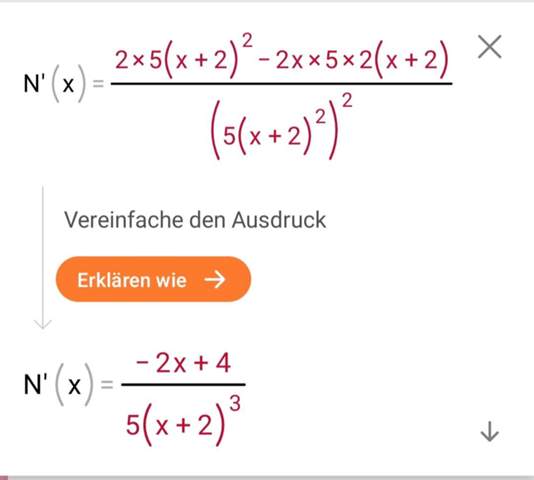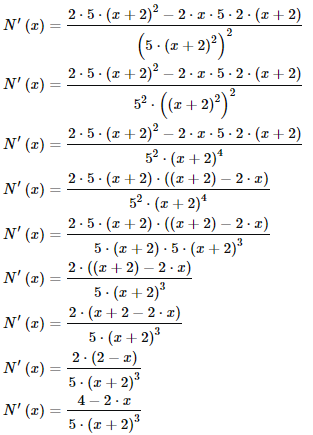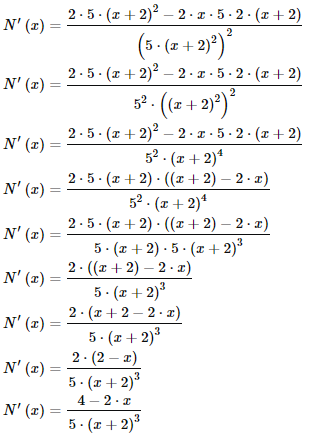Bruch kürzen?

Kann mir jemand erklären wie man hier vereinfacht, ich möchte das verstehn
2 Antworten

Du musst einfach nur den oberen Term faktorisieren und ab da ist es trivial:

LaTeX-Code für interessierte:
\begin{align*}
N^{\prime}\left( x \right) &= \frac{2 \cdot 5 \cdot \left( x + 2 \right)^{2} - 2 \cdot x \cdot 5 \cdot 2 \cdot \left( x + 2 \right)}{\left( 5 \cdot \left( x + 2 \right)^{2} \right)^{2}}\\
N^{\prime}\left( x \right) &= \frac{2 \cdot 5 \cdot \left( x + 2 \right)^{2} - 2 \cdot x \cdot 5 \cdot 2 \cdot \left( x + 2 \right)}{5^{2} \cdot \left( \left( x + 2 \right)^{2} \right)^{2}}\\
N^{\prime}\left( x \right) &= \frac{2 \cdot 5 \cdot \left( x + 2 \right)^{2} - 2 \cdot x \cdot 5 \cdot 2 \cdot \left( x + 2 \right)}{5^{2} \cdot \left( x + 2 \right)^{4}}\\
N^{\prime}\left( x \right) &= \frac{2 \cdot 5 \cdot \left( x + 2 \right) \cdot \left( \left( x + 2 \right) - 2 \cdot x \right)}{5^{2} \cdot \left( x + 2 \right)^{4}}\\
N^{\prime}\left( x \right) &= \frac{2 \cdot 5 \cdot \left( x + 2 \right) \cdot \left( \left( x + 2 \right) - 2 \cdot x \right)}{5 \cdot \left( x + 2 \right) \cdot 5 \cdot \left( x + 2 \right)^{3}}\\
N^{\prime}\left( x \right) &= \frac{2 \cdot \left( \left( x + 2 \right) - 2 \cdot x \right)}{ 5 \cdot \left( x + 2 \right)^{3}}\\
N^{\prime}\left( x \right) &= \frac{2 \cdot \left( x + 2 - 2 \cdot x \right)}{ 5 \cdot \left( x + 2 \right)^{3}}\\
N^{\prime}\left( x \right) &= \frac{2 \cdot \left( 2 - x \right)}{ 5 \cdot \left( x + 2 \right)^{3}}\\
N^{\prime}\left( x \right) &= \frac{4 - 2 \cdot x}{ 5 \cdot \left( x + 2 \right)^{3}}\\
\end{align*}


Beispielsweise so...
Im Zähler des Bruchs kann man 5 und (x + 2) ausklammern.
Im Nenner kann man das äußere Quadrat auf die Faktoren 5 und (x + 2)² verteilen.
Im Zähler kann man 2 * (x + 2) zu 2x + 2 * 2 und weiter zu 2x+4 ausmultiplizieren, und dahinter erhält man 2x * 2 = 4x.
Im Nenner kann man ((x+2)²)² zu (x + 2)^(2 * 2) und weiter zu (x + 2)⁴ zusammenfassen.
Den Faktor 5 im Zähler kann man mit einer 5 von 5² = 5 * 5 im Nenner kürzen, sodass im Nenner noch ein Faktor 5 übrigbleibt. Den Faktor (x + 2) im Zähler kann man mit einem (x + 2) von (x + 2)⁴ = (x + 2) * (x + 2)³ im Nenner kürzen, sodass im Nenner noch ein Faktor (x + 2)³ übrig bleibt.
Im Zähler kann man dann schließlich noch 2x - 4x zu -2x zusammenfassen.
